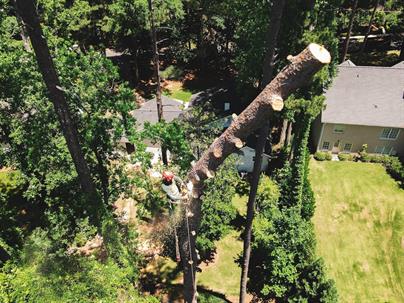If you’re a homeowner in Lawrenceville, keeping your trees healthy is about more than curb appeal—it’s about protecting your home, family, and property value. Tree diseases spread quickly in Georgia’s climate, and knowing what to look for can save you from costly removal or storm damage. Acting early often means the difference between saving a tree and losing it.
Need tree disease care or trimming in Lawrenceville? Call ArborForce Tree Services at (470) 319-6625 or send us a message online today.
Common Tree Diseases in Lawrenceville
Georgia’s warm, humid climate creates perfect conditions for fungi and pests. Local homeowners often deal with oak wilt, root rot, and anthracnose, along with blights that target pines and maples.
- Oaks: Wilt disease spreads fast through root systems and causes rapid browning and leaf drop.
- Pines: Pine wilt and needle blight lead to discoloration and dieback, sometimes within one season.
- Maples & Dogwoods: These favorites in Gwinnett County frequently develop anthracnose or powdery mildew, both showing through leaf spots, curling, and early drop.
Location also influences risk. Trees near construction, compacted soils, or poor drainage tend to develop stress-related diseases more quickly.
Early Signs of Tree Disease
Spotting disease early gives you the best chance to save a tree. Watch for these changes:
- Leaves turning yellow or brown outside of fall.
- Branches dying back on one side of the canopy.
- Mushrooms or fungal growth on bark or at the base.
- Cracks, peeling bark, or wet, oozing sap.
Sometimes symptoms cluster—such as leaf spots on multiple branches or groups of limbs dying at once. That often means infection has spread and needs immediate attention.
Symptoms You Should Never Ignore
Some tree disease signs point to serious safety risks:
- Large cracks in the trunk.
- Soft, crumbling wood or peeling bark.
- Shelf-like mushrooms on the trunk or base.
- Soil movement or exposed roots.
Trees showing these problems are far more likely to fail during storms. Calling an arborist right away helps prevent damage to your home, vehicles, and neighbors’ property.
What to Do If a Tree Looks Sick
If you notice signs of disease, take clear photos and note when the symptoms started. Avoid pruning on your own, since improper cuts or timing can make infections worse. Keep people away from unsafe trees until they’re inspected.
Our team at ArborForce Tree Services uses local experience and professional diagnostic tools to identify the problem. From there, we recommend the safest course of action—whether it’s treatment, pruning at the right time, or full removal.
Best & Worst Times to Trim
Timing makes a huge difference.
- Best: Late winter and very early spring, when trees are dormant and disease spread is low.
- Oak trees: Always trim in January–February to avoid attracting beetles that spread oak wilt.
- Pines: November through February is safest to limit beetle and wilt risk.
- Maples & Dogwoods: Late fall after leaves drop works best.
- Worst: Late spring through summer, when pests and diseases are most active. Cutting during this time leaves wounds open to infection.
Can Trimming Save a Diseased Tree?
Trimming can slow disease when done properly, but it must be performed at the right time and with sanitized tools. Cutting too much live tissue or pruning during the wrong season often causes more harm. Some diseases, like trunk decay, spread so deeply that removal is the only safe option.
At ArborForce Tree Services, we sanitize between cuts and focus on preserving healthy structure while removing problem areas. Each decision comes from careful inspection, not guesswork.
Professional Diagnosis & Care
Accurate diagnosis often requires more than a visual check. Our certified arborists may drill to test for internal decay or send samples to a lab. Treatment depends on the problem and may include safe fungicides, pruning, or support systems for weakened structures.
Every step is documented and explained so you know why it matters and what to expect.
Year-Round Prevention
Healthy trees need consistent care. Preventative steps include:
- Annual professional inspections in spring and fall.
- Deep, infrequent watering in well-drained soil.
- Mulch placed near but not touching the trunk.
- Prompt removal of fallen leaves and branches.
- Avoiding mower or construction damage near root zones.
Consistent attention helps protect your trees from Lawrenceville’s unpredictable weather and frequent pest cycles.
Why Local Tree Care Matters
Generic advice online often overlooks Georgia’s unique soil and climate. Local care accounts for these challenges and ensures your property gets the right solutions. ArborForce Tree Services brings years of Lawrenceville-specific experience, modern equipment, and a commitment to safe, clear communication. From disease management to trimming, we deliver thorough results that protect your property.
Need tree trimming or disease diagnosis in Lawrenceville? Call ArborForce Tree Services at (470) 319-6625 or contact us online today.

